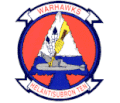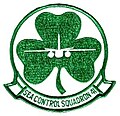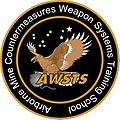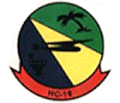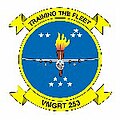Currently Active USN and USMC Fleet Replacement Squadrons
Since the disestablishment of RCVW-4, RCVW-12, RCVSG-50 and RCVSG-51 in 1970 all U.S Navy Fleet Replacement Squadrons (FRS)s are placed organizationally under the Type Wing commander for the respective aircraft type/model. U.S Marine Corps Fleet Replacement Squadrons are organizationally aligned under a Marine Aircraft Group (MAG) which operates that type/model aircraft.
US Navy
| Insignia | Squadron Designation | Squadron Lineage [1] | Current Aircraft | Wing | Notes |
|---|---|---|---|---|---|
 | HSC-2 Fleet Angels | HC-2(2nd): 1 Apr 1987-24 Aug 2005 HSC-2: 24 Aug 2005–present | MH-60S Seahawk | Helicopter Sea Combat Wing, U. S. Atlantic Fleet | NS Norfolk, VA Established 1 Apr 1987 as the second squadron designated HC-2. Became an FRS in 1997. The earlier squadron designated HC-2 also called "Fleet Angels" existed from 1 Apr 1948 to 30 Sep 1977. |
 | HSC-3 Merlins | HC-3: 1 Sep 1967-31 Oct 2005 HSC-3: 31 Oct 2005–present | MH-60S Seahawk | Helicopter Sea Combat Wing, U. S. Pacific Fleet | NAS North Island, CA Established 1 Sep 1967 as HC-3. Became an FRS in 1982. |
 | HSM-40 Air Wolves | HSL-40: 4 Oct 1985-1 Nov 2009 HSM-40: 1 Nov 2009–present | MH-60R Seahawk | Helicopter Maritime Strike Wing, U. S. Atlantic Fleet | NS Mayport, FL Established 4 Oct 1985 as HSL-40 as an FRS. |
 | HSM-41 Sea Hawks | HSL-41: 21 Jan 1983-8 Dec 2005 HSM-41: 8 Dec 2005–present | MH-60R Seahawk | Helicopter Maritime Strike Wing, U. S. Pacific Fleet | NAS North Island, CA Established 1 Jan 1983 as HSL-41 as an FRS. |
 | VAQ-129 Vikings | VAH-10: 1 May 1961-1 Sep 1970 VAQ-129: 1 Sep 1970–present | EA-18G Growler | Electronic Attack Wing, U.S. Pacific Fleet | NAS Whidbey Island, WA Established 1 May 1961 as VAH-10. Became an FRS in 1971. |
 | VAW-120 Grey Hawks | RVAW-120: 1 Jul 1967-1 May 1983 VAW-120: 1 May 1983 – present | E-2C,D Hawkeye C-2A Greyhound | Airborne Command & Control and Logistics Wing | NAS Norfolk, VA Established 1 Jul 1967 as RVAW-120 as an FRS. |
 | VFA-106 Gladiators | VFA-106: 27 Apr 1984–present | F/A-18E, F/A-18F Super Hornet | Strike Fighter Wing, U.S. Atlantic Fleet | NAS Oceana, VA Established 27 Apr 1984 as an FRS. Adopted nickname and insignia of VA-106 which had been disestablished in 1969. |
 | VFA-122 Flying Eagles | VFA-122: 1 Oct 1998–present | F/A-18E, F/A-18F Super Hornet | Strike Fighter Wing, U.S. Pacific Fleet | NAS Lemoore, CA Established 1 Oct 1998 as an FRS. Adopted nickname and insignia of VA-122 which had been disestablished in 1991. |
 | VFA-125 Rough Raiders | VFA-125: 13 Nov 1980–present (inactive 1 Oct 2010 – 12 Jan 2017) | F-35C Lightning II | Joint Strike Fighter Wing | NAS Lemoore, CA Established 13 Nov 1980 as an FRS. Adopted nickname and insignia of VA-125 which had been disestablished in 1977. Deactivated on 1 Oct 2010 as a Hornet FRS and reactivated [2] as a F-35C FRS on 12 Jan 2017. |
 | VP-30 Pro's Nest | VP-30: 30 Jun 1960–present | EP-3 Aries II P-8A Poseidon | Commander, Patrol and Reconnaissance Group | NAS Jacksonville, FL Established 30 Jun 1960 as an FRS. |
 | VQ-7 Roughnecks | Naval Training Support Unit: 1992-1 Nov 1999 VQ-7: 1 Nov 1999–present | E-6B Mercury | Strategic Communications Wing ONE | Naval Air Facility Tinker AFB, OK Established 1 Nov 1999 as an FRS. |
 | VRM-50 Sunhawks | VRM-50: 1 Oct 2019 – present [3] | CMV-22B Osprey | Fleet Logistics Multi-Mission Wing | NAS North Island, CA Established 1 Oct 2019 as an FRS |
 | VUQ-10 Pathfinders | VUQ-10: 1 Oct 2022-present | MQ-25 Stingray | Airborne Command & Control and Logistics Wing | NAS Patuxent River, MD Engaged with VX-23, UX-24 and VX-1 to test, train and develop operational and maintenance procedures for the MQ-25 Stingray. To relocate to NAVBASE Ventura County Point Mugu, CA by 2026 to begin operations as an FRS |
US Marine Corps
| Insignia | Squadron Designation | Current Aircraft | Marine Aircraft Group | Station |
|---|---|---|---|---|
 | HMHT-302 | CH-53 Super Stallion | MAG-29 | MCAS New River, NC |
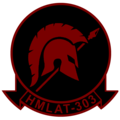 | HMLAT-303 | Bell AH-1Z Viper Bell UH-1Y Venom | MAG-39 | MCAS Camp Pendleton, CA |
 | VMMT-204 | MV-22 Osprey | MAG-26 | MCAS New River, NC |
 | VMFAT-501 | F-35B Lightning II | MAG-31 | MCAS Beaufort, SC |
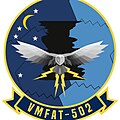 | VMFAT-502 | F-35B Lightning II | MAG-11 | MCAS Miramar, CA |
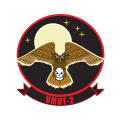 | VMUT-2 | MQ-9A Reaper (Future) | MAG-14 | MCAS Cherry Point, NC |




















